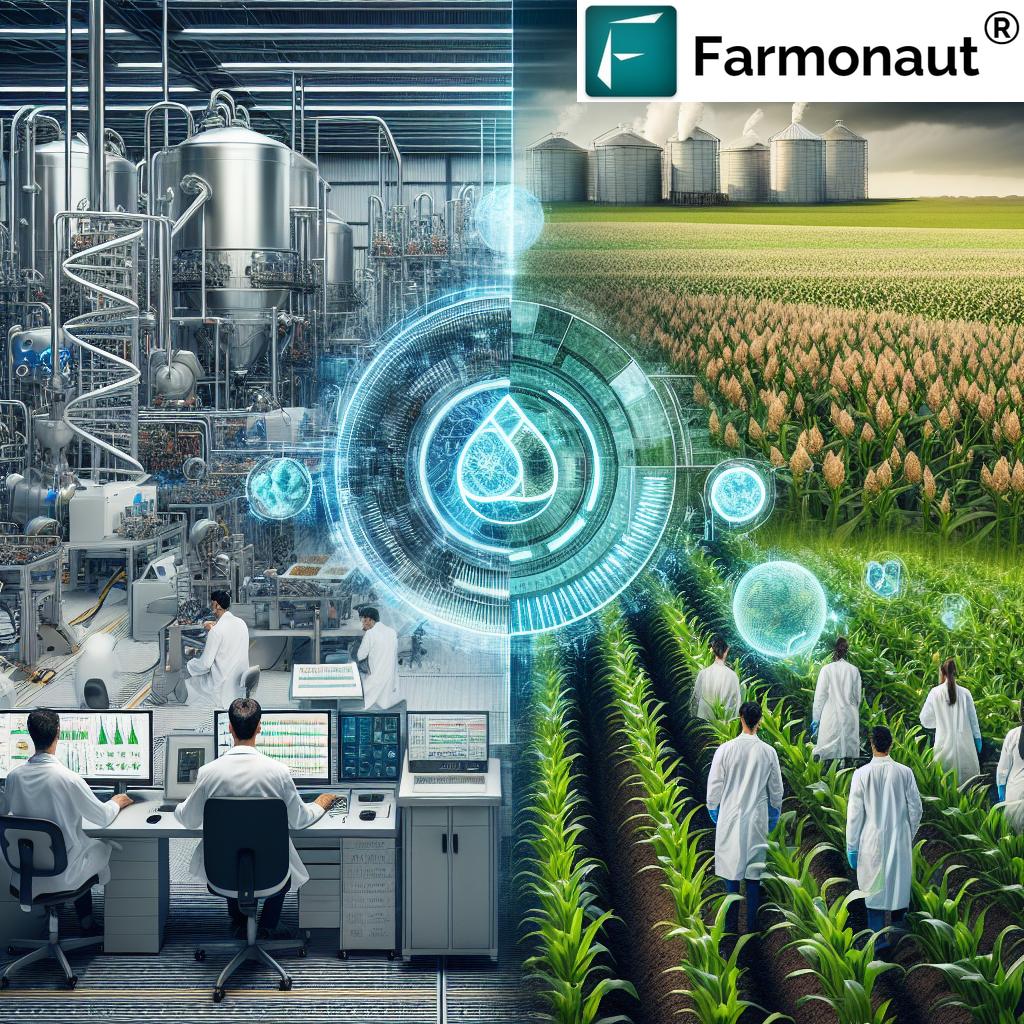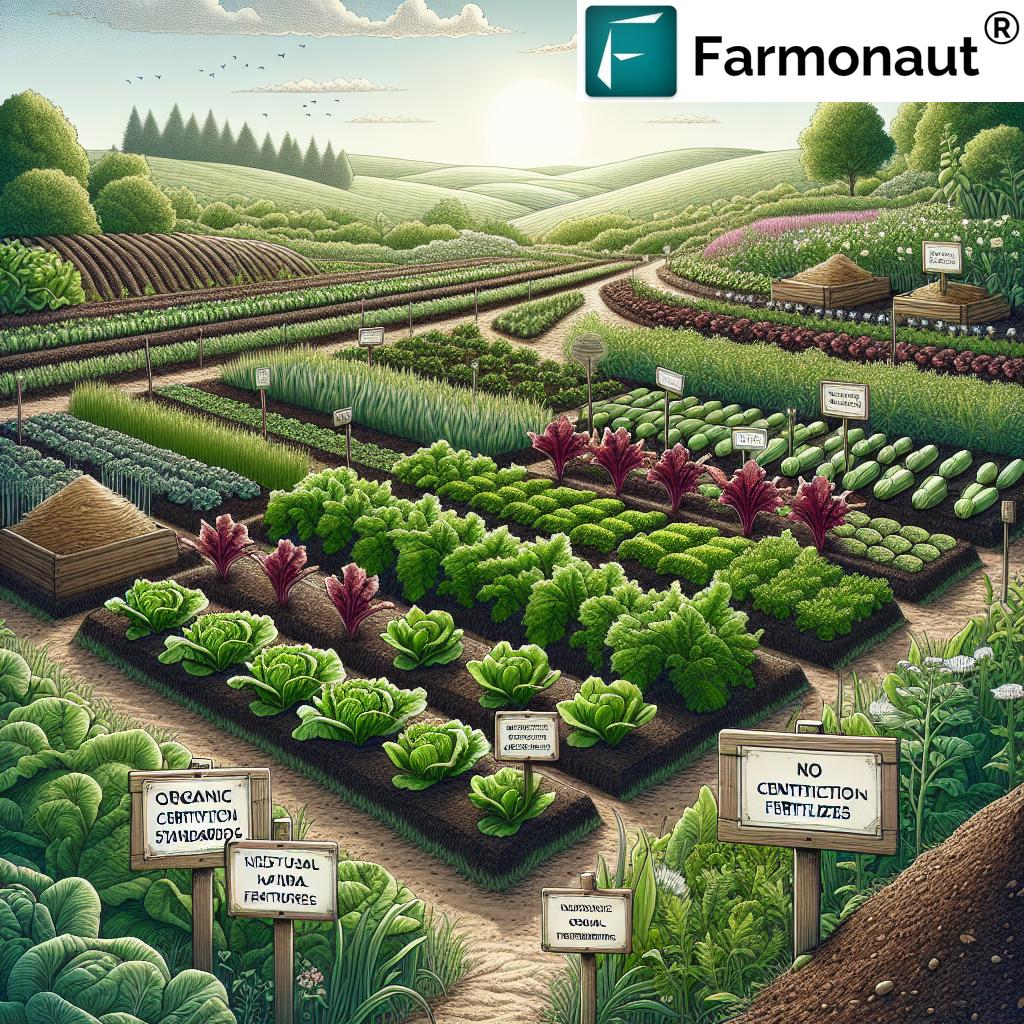Family Farms Market 2026: Dairy & Insurance Trends
Meta Description: Family farms market resilience in 2026—dairy, insurance, and technology trends. Explore family farm challenges, marketplace shifts, and risk management.
Summary: The Evolving Landscape of Family Farms in 2025: Challenges and Opportunities
Table of Contents
- Family Farms Market in 2025 and 2026: Overview and Focus Keyword Impact
- Dairy Trends: The Family Milk Cow Tradition Meets Modern Technology
- Technology and Digital Transformation in Family Farms Market
- Family Farm Insurance Needs: Risk Management in 2026
- Family Farm Seaside: Unique Geographic and Environmental Challenges
- Integrated Farm and Family Insurance Solutions
- Comparative Trends Table: Dairy and Insurance in Family Farms (2024–2026)
- Sustainability and Resilience: Looking Ahead to the Future
- How Farmonaut Empowers Family Farms: Digital Advisory, Monitoring, and Security
- FAQs: Family Farms, Dairy Markets & Insurance Trends 2026
“By 2026, over 65% of family farms plan to update insurance policies to cover new agri-tech risks.”
Family Farms Market in 2025 and 2026: Overview and Focus Keyword Impact
Family farms have been the backbone of agricultural productivity and rural economies worldwide, sustaining food supply chains and representing a living link to heritage and tradition. As we look ahead to 2025 and 2026, several evolving factors reshape the family farms market—from market dynamics and technology to specialized insurance products and shifting distribution channels.
Key trends include:
- Rapid consolidation and competitive pressure: Major agribusiness firms remain dominant, but family farms leverage niche markets for resilience and growth.
- Direct-to-consumer sales: Online platforms and urban consumers seeking provenance and sustainably sourced food support a robust market for family farm products.
- Diversification: From switching crops to producing organic or specialty goods like artisanal cheeses, family farms embrace value-added approaches to remain relevant.
- Climate change adaptation: New environmental challenges such as extreme weather create the need for stress-resistant varieties and sustainable farm management techniques.
- Insurance adoption: Family farm insurance is expanding in coverage, helping protect operations against risks from weather, technology, health, and more.
Understanding the current state and future outlook for family farms is crucial for sustaining agricultural productivity, rural life, and the broader economies they support. The following sections explore dairy trends, insurance needs, technology, and the unique landscape of family farms seaside.
Dairy Trends: The Family Milk Cow Tradition Meets Modern Technology
Dairy farming remains a core aspect of the family farm, with the family milk cow symbolizing economic stability and heritage. However, in the rapidly changing landscape of 2025 and 2026, tradition meets innovation as technology transforms management and productivity.
The Modern Family Milk Cow: Combining Heritage with Technology
-
Automated milking systems:
Modern milking machines and wearable sensors track milk yields, health metrics, and animal welfare. This technology increases efficiency for smaller family farms, narrowing the gap with large-scale operations. -
Precision feeding and health monitoring:
AI-driven feed systems and daily health checkups improve milk quality and reduce costs. Early detection of illness through sensors means family livestock remain healthy and more productive. -
Breeding programs and sustainable pasture management:
Selective breeding enhances livestock genetics for higher productivity and disease resistance, while regenerative soil strategies support environmental sustainability.
Notably, 63% of dairy-focused family farms report technology upgrades as a top strategy for market resilience by 2025, reflecting the accelerating embrace of innovation for competitive advantage.
Product Diversification for Dairy Family Farms Market
- Value-added dairy products: Family farms are increasingly moving beyond commodity milk into artisanal cheeses, yogurt, and even skincare goods derived from milk proteins.
- Direct-to-consumer marketing: Social media and online order platforms are allowing family farms to reach broader audiences and bypass traditional distribution bottlenecks.
- Sustainability claims: Consumers are motivated to pay premiums for brands offering transparent provenance and sustainably sourced food, reinforcing the shift to sustainable practices.
For family dairy operations, these advances help reduce environmental footprints and appeal to urban and health-conscious consumers.
Technology and Digital Transformation in Family Farms Market
As digital transformation accelerates, family farms in 2025 and 2026 are leveraging technology for smarter management, improved security, and optimized productivity. This shift is essential to compete with larger agribusiness and steadily rising global standards.
- Satellite and AI-powered crop monitoring: Remote sensing tools, such as those offered by Farmonaut, provide real-time insights into vegetation health, soil conditions, and crop progress. Satellite data supports drought and pest risk analysis, irrigation optimization, and targeted interventions.
- Blockchain-based traceability: As consumer demand for transparent supply chains grows, blockchain technology enables family farms to prove provenance and sustainability. This traceability increases trust and enables premium pricing for authentic, ethical products.
- Fleet and resource management: Connected IoT and fleet solutions reduce operational costs and ensure farm machinery efficiency.
- Weather prediction and risk alerts: Real-time forecasting and warnings help reduce risks associated with extreme weather, improving harvest timing and reducing losses.
Farmonaut’s Web Platform enables family farms to monitor their crops via satellite & AI. Access your fields anywhere, identify risks early, and make data-driven decisions to improve yield and sustainability.
Smart technology adoption not only future-proofs family farms but also contributes to environmental sustainability by helping reduce chemical inputs, minimizing water usage, and lowering environmental footprints.
Mobile Access and API Integration:
-



- Explore Farmonaut’s API—integrate satellite data with your own agri-management systems for real-time operational insights.
- Developer Documents: Satellite & Weather API—for custom agri-data and remote monitoring solutions.
“63% of dairy-focused family farms report technology upgrades as a top strategy for market resilience by 2025.”
Family Farm Insurance Needs: Risk Management in 2026
Risk management is critical for the survival and resilience of family farms. In 2026, farm and family insurance evolves to address broader and more complex risks:
- Crop failures driven by unpredictable climate change and extreme weather.
- Outbreaks of livestock disease threatening both food supply and farm income.
- Equipment breakdown or loss from theft, impacting ongoing operations.
- Market volatility causing significant drops in product prices or demand.
- Emerging technology-linked risks such as cyberattacks on farm management platforms, drones, and IoT devices.
Family farm insurance in 2026 is becoming more specialized and flexible:
- Tailored coverage: Policies can be adjusted for unique location challenges (such as family farm seaside), asset complexity, and production types.
- Bundled insurance solutions: Comprehensive plans cover crop failures, livestock loss, liability, income loss, and even technology-related threats in one product.
- Integration with digital advisory platforms: Modern farm insurance is being sold with digital monitoring via mobile and web apps for ongoing risk assessment, alerts, and streamlined claims.
By 2026, over 65% of family farms will update insurance policies to include agri-tech specific risks, including data privacy, cyber threats, and AI advisory errors, in alignment with the sector’s tech-enabled transition.
The Crop Loan & Insurance Platform on Farmonaut allows financial institutions and farmers to use satellite-verified farm monitoring, reducing fraud and accelerating the processing and approval of loans and insurance for family farms.
Family Farm Seaside: Unique Geographic and Environmental Challenges
Family farm seaside operations—those found along coastlines or near major inland waterways—face unique environmental and regulatory challenges:
- Rising sea levels and saltwater intrusion impact soil quality and crop viability.
- Increased frequency and intensity of extreme weather events such as hurricanes, floods, and storm surges.
- Protection of livestock and infrastructure from unpredictable environmental hazards.
- Compliance with environmental regulations for coastal farming and sustainable land use.
Strategies for Seaside Family Farms Include:
- Investing in flood defense and advanced soil management technologies, such as salt-tolerant crops and improved drainage.
- Adoption of agro-tourism and aquaculture to diversify income beyond traditional commodity crops.
- Partnering with insurance providers for specialized policies covering coastal risks and disaster response.
Satellite monitoring platforms play a vital role for family farm seaside businesses by:
- Delivering early warnings for storms, floods, and soil erosion risks based on real-time satellite imagery.
- Supporting compliance reporting through geo-tagged records for insurance and regulatory submissions.
- Enabling ongoing monitoring of coastal crops and environmental changes with minimal onsite presence.
Farmonaut’s Plantation & Forest Advisory Solution empowers family farms in coastal zones to predict soil salinity, plan for coastal risks, and diversify operations with improved forest and crop planning.
Integrated Farm and Family Insurance Solutions: Protecting Operations and Livelihoods
On the family farm, operations and family welfare are often inseparable. Leading farm and family insurance providers now offer bundled policies that combine:
- Property and crop insurance: Insuring against loss, disaster, and crop yield shortfalls.
- Health, life, and disability protection: Covering family members directly involved in daily farming activities, ensuring continuity of the enterprise.
- Liability insurance: Protecting against claims from product recalls, accidents, or environmental incidents.
- New tech risk coverage: Protection against technology-driven operational errors or losses, increasingly necessary as family farms digitize.
Such integrated risk management solutions boost the security and sustainability of family farm operations, enabling families to withstand market shocks and environmental extremes, while enabling smoother generational transitions and future growth.
For farms adopting digital advisory and monitoring, insurance-linked software can streamline claims, foster proactive risk assessments, and incentivize data-driven management.
Comparative Trends Table: Dairy and Insurance in Family Farms (2024–2026)
Key Market Data: How the Family Farms Market is Changing
| Year | Dairy Market Size (USD, estimated) | Insurance Adoption Rate (%) | Major Technology Adoption | Key Market Trend |
|---|---|---|---|---|
| 2024 | $95B | 52% | 42% (Wearable sensors and automation) | Consolidation, early digitalization, niche marketing emerges |
| 2025 | $101B | 59% | 55% (AI, satellite, digital advisory adoption) | Surging direct-to-consumer sales, focus on sustainability |
| 2026 (Projected) | $112B | 67% | 70% (integrated farm management, full traceability, advanced insurance) | Bundled insurance & tech-driven risk management mainstream; climate adaptation key |
Estimated figures for illustration; actual values may vary by region and market movement. Use for strategic planning in family farms market.
Sustainability and Resilience: Looking Ahead to 2026 and Beyond
The sustainability and resilience of family farms in 2026 depend on continuing to innovate while honoring core values of stewardship, community, and heritage. The following points highlight the strategies, opportunities, and programs that will help family farms face challenges and seize opportunities:
-
Participation in government programs:
Funding support for tech investment, insurance upgrades, and climate adaptation will remain vital, especially for smaller operations. -
Cooperative networks:
Pooling resources helps with bulk purchasing, sales negotiations, and risk-sharing insurance models. -
Private sector digitalization:
Technology platforms (including satellite, AI, and blockchain) will be increasingly affordable, scalable, and integrated. -
Generational renewal:
Next-generation farmers are embracing data-driven farming, environmental stewardship, and flexible business models—ensuring continuity of family farm legacies.
Environmental monitoring tools—such as carbon footprint tracking from Farmonaut—support sustainability programs and help family farms comply with future regulations and market demands for sustainable produce.
Looking ahead, family farms that embrace evolving technology, robust risk management, and diversified market strategies will remain resilient and vital to global food security.
How Farmonaut Empowers Family Farms: Digital Advisory, Monitoring, and Security
As a pioneering satellite technology provider, Farmonaut offers advanced solutions specifically tailored to the evolving needs of family farms and rural agricultural operators. Our platform delivers:
- Real-time satellite monitoring for crop health, soil conditions, and livestock management.
- Jeevn AI advisory for seasonal forecasts, risk mitigation, and resource optimization.
- Blockchain-based traceability supporting transparent supply chains and improved insurance compliance.
- API and mobile app access for seamless integration and remote farm operation—on web, Android, and iOS.
- Environmental impact tracking supporting sustainability certifications and government programs.
For banks and insurance companies, Farmonaut enables satellite verification and risk assessment for faster, safer agricultural loan and insurance processes.
With affordable monthly subscriptions, family farms access satellite imagery, AI insights, and trusted digital records to minimize risk, optimize productivity, and ensure future-proof resilience.
FAQs: Family Farms, Dairy Markets & Insurance Trends 2026
What is driving the evolution of the family farms market in 2025–2026?
The family farms market is shaped by increasing pressure from agribusiness consolidation, rapid adoption of precision and AI technology, changing consumer preferences for sustainable and traceable food, and a growing need for specialized insurance coverage.
How are family milk cow operations adapting to new technological advances?
Family milk cow management is leveraging automated milking, wearable health sensors, AI-driven feeding, and advanced breeding. These advances enhance animal welfare, improve milk quality and yield, and reduce environmental footprints through smarter forage and manure management.
What’s new in family farm insurance for 2026?
Insurance products now offer integrated coverage for climate risk, cyber threats, health protection for farm families, technology failures, and liability. Policies are more flexible, with bundled options and digital advisory integration becoming standard.
Why do seaside family farms need special risk management strategies?
Seaside family farms face saltwater intrusion, rising sea levels, and increased storm risk. They’re adopting climate-smart technology, salt-tolerant crops, and specialized insurance to sustain productivity and manage unique environmental risks.
How does Farmonaut support the evolving needs of family farms?
Farmonaut’s platform combines satellite monitoring, AI-powered advisory, blockchain product traceability, and environmental impact tracking. These tools help family farms increase productivity, strengthen risk management, comply with sustainability requirements, and access faster finance and insurance services.
How can a family farm access Farmonaut’s solutions?
Family farms can start using Farmonaut by registering via the web app, Android, or iOS app. APIs and developer tools are also available for integration with existing farm management systems.
Conclusion: The Future of Family Farms Market & Dairy and Insurance Trends
Family farms in 2026 remain resilient and vital despite global challenges. As the market evolves to embrace digital transformation, sustainability, and advanced insurance practices, these farms continue to play a leading role in agricultural productivity and rural economies worldwide. Adopting smart management tools, leveraging insurance for security, and innovating with new products will ensure the backbone of our food system remains strong for generations to come.
For those interested in traceability, digital monitoring, or affordable insurance-linked solutions, Farmonaut offers a flexible web and mobile platform that supports family farm sustainability and resilience for 2026 and beyond.









